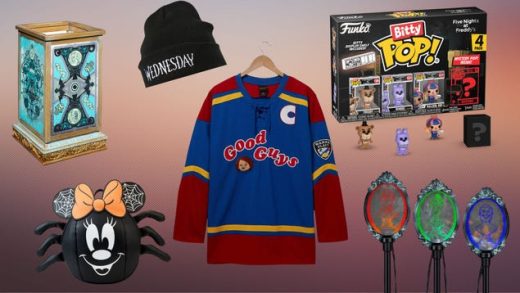Today sees the release of The Iron Claw, a tear-jerking drama that unfurls the true, tragic story of the Von Erich clan, a family of pro-wrestlers rumored to have been laid low by a vicious curse. Sean Durkin’s adaptation includes stars like Zac Efron, The Bear‘s Jeremy Allen White, Lily James, and Harris Dickinson. But if this abridged version of wrestling history leaves you hankering for more, we recommend turning to your TV, specifically Dark Side of the Ring.
Playing like a true crime show that focuses on wrestling stars, Dark Side of the Ring risks being a tawdry tabloid series. However, over each 44-minute episode, creators Evan Husney and Jason Eisener provide a succinct yet satisfying look at the heroes, villains, and victims of an industry that’ll hold you up, then smack you down without mercy. This docu-series has a profound empathy that urges audiences to understand there was more to these men and women than their personas in the ring.
Dark Side of the Ring gives more details on the Von Erich tragedy.
A good starting point is Season 1, episode 4: “The Last of the Von Erichs.” Whether you’ve just seen The Iron Claw and want to know more or you’d like to know what the film left out, this ep is a must-see.
Archival footage presents the heyday of the Von Erichs, from their father Fritz playing a Nazi-inspired heel in the 1960s to brothers Kerry, Kevin, Kris, Mike, and David tearing it up as a team in the ring in the ’80s. Newsreels of funerals reveal how the series of deaths in the family — including three by suicide — was felt across the wrestling world. Family photos show moments of peace and play. Artfully done re-enactments fill in the gaps, with brawny doubles playing the brothers in muted scenes while interviews with friends like Fritz’s “right hand man” David Manning and wrestling historian Jim Cornette provide sharp context to what the family was going through at any given moment. But the most moving testimonials come from Kevin Von Erich, the last man standing.
Now living in Kauai with a sprawling family of his own, sixty-something Kevin reflects on his father, his brothers, and the world-shattering grief that pinned them again and again. Yet Kevin doesn’t come off as a man lost to mourning. Instead, the episode ends with Kevin speaking of finding peace, projecting a sense of hope in Dark Side of the Ring.
Dark Side of the Ring is addictive.
Be warned. With sharp writing, each episode draws in the viewer in moments. First, they tease a bit of the story, displaying flashy costumes or wild re-enactments or juicy details. Next thing you know, you’re deep in the backstory of wrestling legends like Bruiser Brody, New Jack, Jimmy Snuka, and the Fabulous Moolah.
Over the course of four seasons, Dark Side of the Ring lays out all kinds of stories, ranging from tales of murder, drug addiction, obsession, provocation, alleged prostitution, and “the slap heard round the world” — when, in 1984, heel David Schultz smacked reporter John Stossel for calling pro-wrestling “fake.” If the wrestler at the story’s center is alive, they get to give their side, often bolstered by friends and family. But so too do their detractors. And when two versions of a story collide, Dark Side of the Ring allows them to tussle, often without declaring a winner. Such a presentation leaves the audience to make the call. It’s rarely easy, because real life isn’t as black-and-white as the rights and wrongs in the ring.
Dark Side of the Ring plays to fans and newbs alike.
Devotees of WWE, WWF, and UWF might thrill to revisit these stories that riveted over the decades, or they might appreciate the likes of wrestlers Chris Jericho, Mick Foley, and Dutch Mantel sharing their sides. But newcomers won’t be lost by most of the episodes, as the show’s writing is careful to lay out the essentials swiftly. (Admittedly, this viewer did get lost when she wandered into “Bash at the Beach 2000” about dueling promotions, in which a lot of lore clearly lies.) But whatever level of pro-wrestling knowledge you have, the real hook of Dark Side of the Ring is its focus on humanity.
Having binge-watched a bunch of episodes, there are moments that stand out even weeks later. Some are funny, like Cornette writing off writer Vince Russo as a “skidmark on the underwear of humanity.” Some are heartbreaking, like Jericho talking about the final days of wrestlers Chris and Nancy Benoit. But the one that shines in my mind the brightest is the widow of wrestler Bam Bam Bigelow, answering what’d she say if she could speak to him again.
“You motherfucker,” she begins unblinking. But then she acknowledges how therapy has helped her understand he had no control in the addiction that brought an early end to his life. “It’s not your fault.” she continues, but adds with a smile, “But I would call him a motherfucker first. Just because he would expect that.”
It’s a simple moment that shows beautifully and brutally how complex we are, each of us. We’re capable of great anger and great empathy. And both face off in Dark Side of the Ring.
How to watch: Dark Side of the Ring is now streaming on Hulu.







